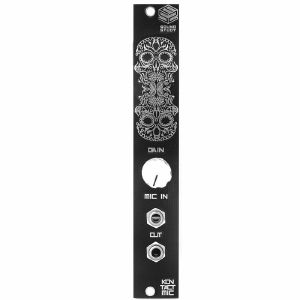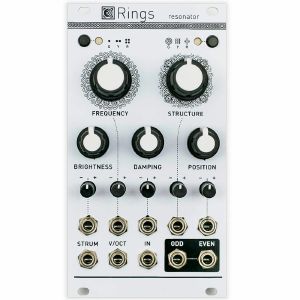Receive new release alerts for Sound Study
Filter
Equipment
Format
Featured
Price
Tags
Items 1 to 2 of 2 on page 1 of 1
Sound Study Modular Kontact Mic Preamp Module (preamp synth module)
Cat: 778088 Rel: 28 May 21
mic module
Notes: The Kontact MIC is a lo-fi theme park. It's a Eurorack microphone preamp with a piezo contact mic built into the panel.
The creative applications are endless: finger percussion/rubbing/scratching, guitar input (works surprisingly well with just a little lofi crunch), acoustic sources to CV, etc.
The PCB fibreglass has quite a nice rough texture - rubbing it with a finger or a plectrum creates quite a wide range of sounds. The back of the panel is plated to expand the surface area of the contact mic. The mic will also pick up all the physical sounds in your modular- patching, cables rustling, switches, fingers on knobs - without picking up airborne sounds i.e. the sound your modular is making. At very high sound levels will pick up vibrations from the speaker output and start to feedback.
The module will work with both DIYed contact mics made from inexpensive piezo transducers, off the shelf contact mics (often called Piezo Pickups) made for guitars and violins which you can pick up for ten bucks from Amazon or eBay or more bespoke mics like the popular Jez Riley French models (including hydrophones!) which are firmly aimed at Sound Designers.
It is an easy way to bring environmental noise and feedback into a modular system, inspired by the early days of electroacoustic music in Paris and Cologne, and by the contact microphone and phonograph cartridge experiments of John Cage, Gordon Mumma, Robert Ashley and Nicholas Collins.
… Read moreThe creative applications are endless: finger percussion/rubbing/scratching, guitar input (works surprisingly well with just a little lofi crunch), acoustic sources to CV, etc.
The PCB fibreglass has quite a nice rough texture - rubbing it with a finger or a plectrum creates quite a wide range of sounds. The back of the panel is plated to expand the surface area of the contact mic. The mic will also pick up all the physical sounds in your modular- patching, cables rustling, switches, fingers on knobs - without picking up airborne sounds i.e. the sound your modular is making. At very high sound levels will pick up vibrations from the speaker output and start to feedback.
The module will work with both DIYed contact mics made from inexpensive piezo transducers, off the shelf contact mics (often called Piezo Pickups) made for guitars and violins which you can pick up for ten bucks from Amazon or eBay or more bespoke mics like the popular Jez Riley French models (including hydrophones!) which are firmly aimed at Sound Designers.
It is an easy way to bring environmental noise and feedback into a modular system, inspired by the early days of electroacoustic music in Paris and Cologne, and by the contact microphone and phonograph cartridge experiments of John Cage, Gordon Mumma, Robert Ashley and Nicholas Collins.
1 in stock $62.79
Click for better price!
or call +44 20 7424 1960
quote 778088
quote 778088
Sound Study Rings Resonator Module (resonator synth module)
Cat: 1040429 Rel: 14 Nov 24
Resonator module - 14HP
Notes: Rings is a resonator, the essential ingredient at the heart of several physical modeling synthesis techniques. The resonator transforms an external, unpitched excitation audio signal into a full-bodied pitched sound. Rings is the bar, the tube or the bunch of strings you cause to vibrate with a bursty external signal.
Any signal can be fed into the resonator, including envelope clicks, trigger signals, noise bursts, even tonal sounds. It also contains a special "polyphonic mode", where four notes can ring together at the same time. Although it is not truly polyphonic, it adds density and chordal characters to the sounds output. For those wanting the functions of Elements without the losing HP real-estate, Rings is exactly the solution.
Three families of vibrating structures are simulated by the module, with CV control over their parameters:
Strings, membranes and tubes as modelled by Elements' resonator section (modal synthesis).
Strings coupled together and vibrating in sympathy, with controllable intervals between them.
Strings with a variable amount of inharmonicity.
Rings can be configured so that each new note is played on its own virtual string, while the previously played note(s) still decay. This unique take on polyphony allows the module to play strummed chords.
Controls
Number of strings/structures (1, 2 or 4).
Synthesis model (modal, sympathetic strings, string).
Main frequency (quantized in semitones).
Structure. With the modal and string models, controls the inharmonicity of the spectrum (which directly impacts the perceived "material"). With the sympathetic strings model, controls the intervals between strings.
Brightness. Specifies the brightness and richness of the spectrum.
Damping. Controls the damping rate of the sound, from 100ms to 10s.
Position. Specifies at which point the structure is excited.
Inputs and Outputs
Frequency, structure, brightness, damping and position modulation CV inputs with attenuverter (-8V to +8V).
"Strum" trigger input to indicate when a new polyphony voice needs to be allocated. Normalized to an edge detector detecting changes on the main V/Oct input, or sharp transients on the audio input. Detection threshold at 0.6V.
1 V/Oct frequency input (-1V to +5V).
Resonator audio input, normalized to a filtered pulse/noise burst triggered by the "Strum" input (for stand-alone use). Modular level, up to 16Vpp.
Two audio outputs, splitting the signal into even/odd partials in monophonic operation, or even/odd notes in polyphonic operation.
Specifications
Module width: 14HP
Module depth: 25mm
Current draw: 120mA @ +12V, 5mA @ -12V
… Read moreAny signal can be fed into the resonator, including envelope clicks, trigger signals, noise bursts, even tonal sounds. It also contains a special "polyphonic mode", where four notes can ring together at the same time. Although it is not truly polyphonic, it adds density and chordal characters to the sounds output. For those wanting the functions of Elements without the losing HP real-estate, Rings is exactly the solution.
Three families of vibrating structures are simulated by the module, with CV control over their parameters:
Strings, membranes and tubes as modelled by Elements' resonator section (modal synthesis).
Strings coupled together and vibrating in sympathy, with controllable intervals between them.
Strings with a variable amount of inharmonicity.
Rings can be configured so that each new note is played on its own virtual string, while the previously played note(s) still decay. This unique take on polyphony allows the module to play strummed chords.
Controls
Number of strings/structures (1, 2 or 4).
Synthesis model (modal, sympathetic strings, string).
Main frequency (quantized in semitones).
Structure. With the modal and string models, controls the inharmonicity of the spectrum (which directly impacts the perceived "material"). With the sympathetic strings model, controls the intervals between strings.
Brightness. Specifies the brightness and richness of the spectrum.
Damping. Controls the damping rate of the sound, from 100ms to 10s.
Position. Specifies at which point the structure is excited.
Inputs and Outputs
Frequency, structure, brightness, damping and position modulation CV inputs with attenuverter (-8V to +8V).
"Strum" trigger input to indicate when a new polyphony voice needs to be allocated. Normalized to an edge detector detecting changes on the main V/Oct input, or sharp transients on the audio input. Detection threshold at 0.6V.
1 V/Oct frequency input (-1V to +5V).
Resonator audio input, normalized to a filtered pulse/noise burst triggered by the "Strum" input (for stand-alone use). Modular level, up to 16Vpp.
Two audio outputs, splitting the signal into even/odd partials in monophonic operation, or even/odd notes in polyphonic operation.
Specifications
Module width: 14HP
Module depth: 25mm
Current draw: 120mA @ +12V, 5mA @ -12V
1 in stock $221.29
Click for better price!
or call +44 20 7424 1960
quote 1040429
quote 1040429
Items 1 to 2 of 2 on page 1 of 1

 USD
USD






